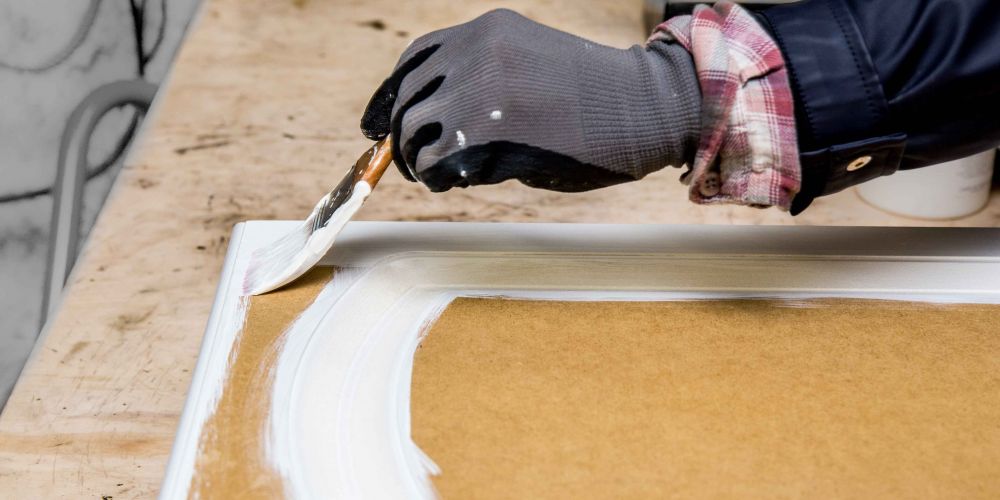Founder
James Bryant is the Founder of Cut My, an online retailer providing quality materials for home improvement and DIY projects. An avid DIY enthusiast himself, James started Cut My to share his passion for building and making things.
Easter Sale - 5% OFF orders £50+ -


Painting medium-density fibreboard (MDF) can transform boring, flat MDF pieces into beautiful, customised furniture or accent pieces. With the right preparation and painting technique, even beginners can achieve professional-looking results. This guide will walk you through the entire process of prepping, priming, painting, and sealing MDF. Follow these simple steps for long-lasting, high-quality paint finishes on MDF projects.
Please be aware that whilst working with MDF sheeting we recommend that you wear a protective mask, as MDF boards can contain formaldehyde which is released either from sanding, sawing, or manipulating. For this reason, we suggest ordering your MDF from us customised when ordering so all that is required are the steps needed in this guide.
The key to success when painting MDF is a proper surface prep and using the appropriate paint and primer. Here are some tips:
Follow these steps to properly prepare, prime, and paint MDF:
Start by wiping down the MDF thoroughly with a damp cloth to remove any dirt, dust, or debris on the surface. Allow the MDF to dry completely after cleaning. Then, use a brush or lint-free rag to apply a thin, even coat of MDF sealer or sanding sealer across the entire surface and edges. Let the sealer soak in fully, then wipe off any excess. Sealing the MDF prevents paint from being absorbed unevenly into the edges and fibres for a smoother painted finish.
Once the surface is clean and sealed, take 220-400 grit sandpaper and lightly sand the entire surface of the MDF as well as the edges. Always sand with the direction of the grain, rather than against it. This light sanding helps to slightly roughen up the MDF surface so the primer and paint can adhere better. Be very careful not to sand away the sealer you just applied. After sanding, wipe off all dust with a dry cloth.
After sanding, it's time to apply primer specially formulated for MDF. Use a high-quality MDF primer and apply two coats, following the product's directions for proper application and drying times between coats. Lightly sand again with fine-grit sandpaper between the coats to ensure a perfectly smooth finish. The primer is essential for sealing the MDF fibres and creating a uniform surface for painting. For the best coverage, consider tinting the primer close to your final paint colour.
Once the primer has fully dried, you can now apply two coats of your chosen acrylic latex paint colour, allowing the recommended drying time between coats. Use high-quality applicators like an angled brush, foam mini roller, or paint sprayer to achieve smooth, consistent coverage. Lightly sanding between paint coats helps get rid of any brush marks or texture inconsistencies for a flawless finish. Carefully follow the paint manufacturer's instructions for application, thinning, and drying times.
After the paint has completely cured and hardened, it's time to add a clear protective finish. Water-based polyurethane is ideal to seal and protect acrylic painted MDF. Apply two to three thin, even coats of polyurethane, lightly sanding between each coat. This clear topcoat prevents chipping, staining, and damage to the painted surface. Alternatively, use paste wax or a non-yellowing varnish to achieve a hardwearing finish.
With proper preparation, quality paint materials, and finishing, your painted MDF will have a smooth, lasting finish that withstands regular use.
It's easy to end up with a lousy paint job on MDF if you miss important preparation and application steps. Here are some key mistakes to avoid:
Satin, semi-gloss, and gloss sheens are recommended for MDF. The slight sheen is easy to clean and resists staining and scuffing.
Chalk paint adheres well to properly sealed and primed MDF. For the smoothest finish, sand between coats and apply a protective topcoat like paste wax.
Most acrylic latex paints fully dry within 2-4 hours, while oil-based paints may take up to 24 hours to cure. Always allow the recommended recoat times between layers.
Painting MDF can help prevent mould growth when done properly. Unfinished MDF is porous and prone to absorbing moisture which can lead to mould. But primer formulated for MDF seals the fibres and prevents moisture absorption. The paint coating provides further protection.
Lightly sanding helps paint grip better, prevents fibres from showing through paint, and creates a smooth finish. Proper sanding between coats is key for good results.
Verified
Verified
Verified
Verified
Verified
Verified
Verified
Verified
Verified
Verified
Verified
Verified
Verified
Verified
Verified
Verified
Verified
Verified
Verified
Verified